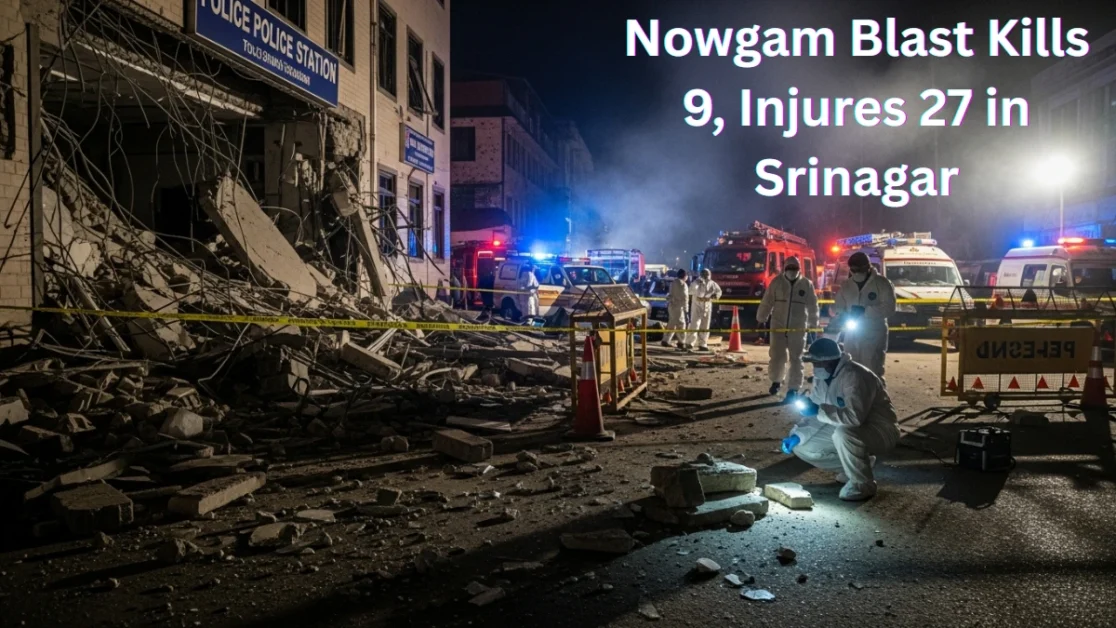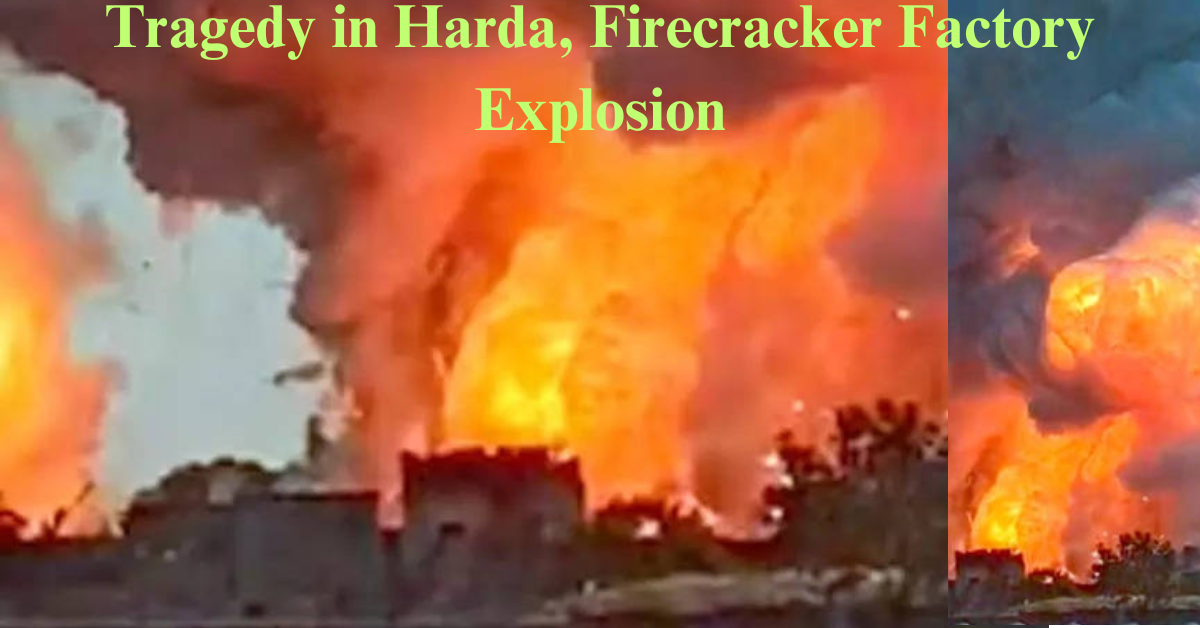
Nowgam Blast Kills 9, Injures 27 in Srinagar
Author: Krishna Arya | Network Bharat
Nowgam Blast : A routine forensic examination turned into one of the year’s deadliest mishaps on Tuesday when a massive blast tore through the Nowgam Police Station in Srinagar, killing nine people and leaving 27 others injured. The explosion occurred while specialists were handling explosive material seized from a Faridabad-based terror module, triggering a disaster no one on site could foresee.
The incident has shaken Jammu & Kashmir’s security establishment, raising serious questions about handling procedures, storage protocols and the rising risks associated with transporting seized explosive material across states.
What Happened at the Nowgam Police Station?
According to officials, a forensic team and J&K Police personnel were examining explosive material — including ammonium nitrate and other components seized during a recent counter-terror operation linked to Faridabad.
During the sampling process, a sudden ignition triggered a powerful blast that ripped through the room, shattered walls, and sent debris flying across the compound.
Eyewitnesses described the chaos as “a thunderous explosion followed by smoke, screams and a frantic rush to help the injured.”
The deceased include forensic experts, technical staff, and police officers who were directly engaged in the sample-testing process.
Why Were Faridabad-Seized Explosives in Srinagar?
The explosives had been recovered as part of an ongoing investigation into a suspected terror network operating between the NCR region and Kashmir.
The material was sent to Nowgam for detailed forensic analysis to trace composition, origin, and possible operational intent.
However, preliminary reviews now suggest that the sensitivity and instability of the seized material may have been underestimated — turning a routine lab task into a tragedy.
What Investigators Are Saying
Senior officials have confirmed that:
- The blast was accidental, not triggered by any hostile action.
- A high-level inquiry committee has been formed, involving forensic science experts from multiple states.
- Attention is now focused on whether adequate safety gear, shielding, and isolation protocols were followed.
A senior officer remarked that “even a single lapse in explosive handling can have catastrophic outcomes — and this incident reflects the urgent need to re-evaluate our guidelines.”
27 Injured — Many Critical
Hospitals in Srinagar have reported a mix of burn injuries, shrapnel wounds, fractures and trauma. Several officers remain in critical condition, and the toll could rise.
Locals rushed to the scene minutes after the explosion, helping evacuate victims and clear debris until emergency teams arrived.
Nationwide Shock and Condolences
Messages of grief poured in from across the country. Security experts emphasized that while terrorism-related investigations are becoming more complex, safety infrastructure hasn’t kept pace.
Many also highlighted the need for dedicated blast-proof testing facilities to prevent such tragedies in the future.
A Wake-Up Call for India’s Explosive-Safety Protocols
The Nowgam blast has reopened a long-standing debate:
Are India’s law-enforcement agencies adequately equipped to handle volatile material seized during investigations?
Experts say the accident underscores multiple issues:
- Lack of standardized, modern explosive-testing labs
- Variations in safety protocols across states
- Transportation risks during inter-state investigation transfers
- Insufficient protective equipment for personnel
The incident is expected to prompt a nationwide safety audit.
Final Thoughts
This devastating accident is more than a headline — it is a reminder of the risks our police and forensic teams face daily. As the investigation progresses, the nation awaits clarity not just on what went wrong, but also on how such tragedies can be prevented in the future.
FAQs
1. What caused the blast at the Nowgam Police Station in Srinagar?
The blast occurred during the forensic handling of explosive material seized from a Faridabad-based terror module. Officials confirmed it was an accidental explosion, likely triggered while samples were being examined.
2. How many people were killed and injured in the Srinagar police station explosion?
The explosion killed nine people and left 27 others injured, including forensic experts and police personnel who were directly involved in the examination process.
3. Why were explosives from Faridabad brought to a police station in Kashmir?
The seized explosives were transported to Srinagar for advanced forensic testing, including composition analysis, origin tracing, and evidence linking to a suspected terror network operating between NCR and Jammu & Kashmir.
4. Was the Srinagar police station blast related to a terror attack?
No. Authorities and the Ministry of Home Affairs have clearly stated that the explosion was not a terror attack. It was an accidental detonation of unstable explosive material during forensic analysis.
5. What type of explosive material triggered the accident?
Preliminary reports suggest components like ammonium nitrate and other sensitive compounds were being examined. Their unstable nature may have caused an unexpected ignition during sampling.
6. Who is investigating the Nowgam Police Station blast?
A high-level inquiry committee, including forensic science experts and senior police officials from multiple states, has been formed to review the blast, identify lapses, and strengthen future safety protocols.
7. Could this accident have been prevented?
Experts believe the tragedy highlights serious gaps in explosive-handling protocols, including the need for blast-proof labs, stricter safety measures, better storage systems, and standardized national guidelines for dealing with volatile materials.
8. Are there more risks associated with transporting seized explosives across states?
Yes. Inter-state movement of explosive material comes with significant risk, especially when dealing with unstable compounds. This accident has renewed calls for dedicated regional forensic facilities to reduce transportation hazards.
9. What steps is the government taking after the Srinagar blast?
Authorities are expected to conduct a nationwide safety review, strengthen explosive-handling norms, and invest in modernized forensic infrastructure to prevent similar incidents in the future.
10. How are the injured victims being treated?
Victims with burn injuries, fractures and shrapnel wounds are being treated in multiple Srinagar hospitals, with several still in critical condition. Medical teams are providing round-the-clock trauma care.
Network Bharat will continue tracking the developments closely.
Sources:
At least 8 killed in huge blast at a police station in Indian-controlled Kashmir (AP News)
Explosion rips through police station in India’s Kashmir, official says (Reuters)
#NowgamBlast #Srinagar #Kashmir #ExplosivesAccident #FaridabadSeizure #PoliceStationBlast #SafetyProtocol #AmmoniumNitrate #IndiaNews #BreakingNews


